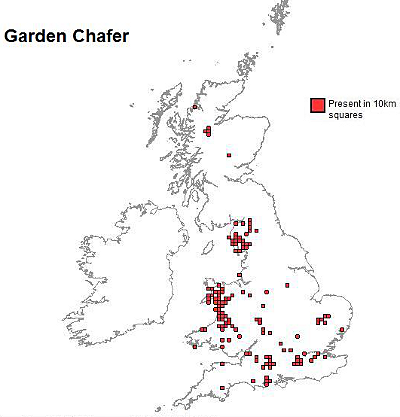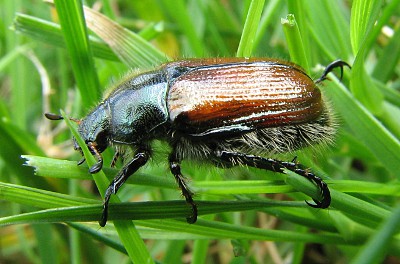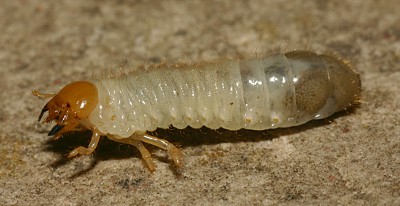The Garden Chafer Phyllopertha horticola has a patchy distribution in the British Isles (see map) but can be locally quite common. It flourishes best in permanent pasture on light soil in hilly country, and occurs from sea-level to an altitude of at least 1,160 ft. It is associated with sandy soils and so not surprisingly it is regularly recorded around Kidderminster. What is surprising is the quantity seen around Kidderminster in 2009. On the morning of the 24th May over five hundred were counted in a garden at Greenhill, Kidderminster.
Adult Garden Chafers are about 9 mm long, the head and mesothorax is a dark metal green to black colour and the elytra is a reddish brown with a metal gloss. The Garden chafer has one generation per year. The adults emerge at the end of May. On leaving their pupae it takes several days before they are fully coloured and hardened. They come to the surface of the soil and flight activity starts, depending on the weather. The adults fly between 10.00 and 12.00 a.m. usually only in sunny weather. The flight period is from the end of May until the second or third week of June, depending on the weather. The males are most noticeable, circling the lawns for females, after mating the females dig in to the turf to lay eggs. Occasionally females will take to the air for a more purposeful flight out of the garden. Later in the year the browning patches are a clue that all is not well with the grass and by August the local newspapers were reporting a mystery ... what was digging up garden lawns with such vigour? Badgers can be blamed for this but in this case it was birds, mainly Magpies who systematically stripped the turf to get at the larvae of Chafers. The reason the chafers have done so well is probably because the last three summers have been much wetter than usual and it is the wet condition that encourages the larvae to easily explore the grass roots of lawns. The larvae are up to 2cm long, "C" shaped, cream coloured with a darker head and can be up to 10 cms below the surface of the soil. The conditions do not need to be too wet, however, and it has been noticed that water logged ground does not favour the larval stages.
Garden Chafer Phyllopertha horticola national distribution derived from the NBN Gateway - http://nbn.org.uk/ - http://data.nbn.org.uk/

Garden Chafer Phyllopertha horticola
Picture ©Mike Averill

Garden Chafer Phyllopertha horticola larva
Picture ©Mike Averill